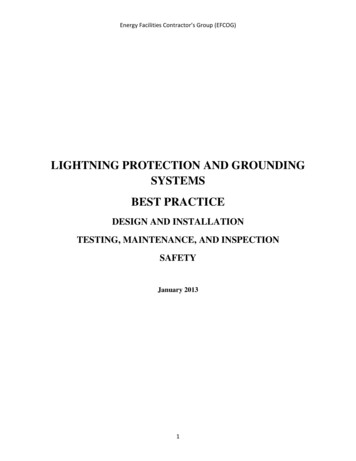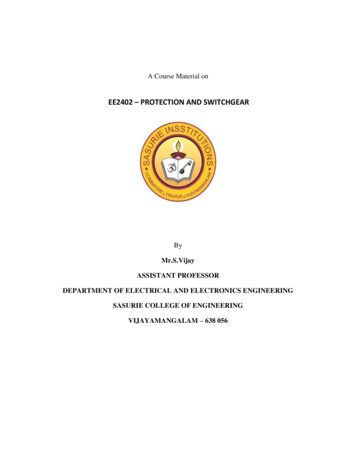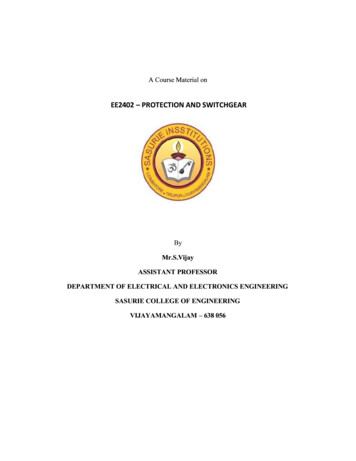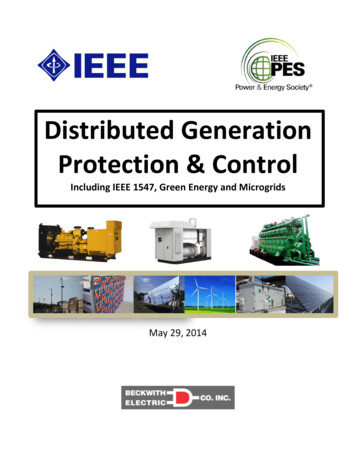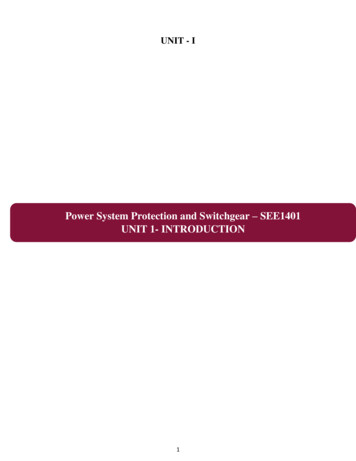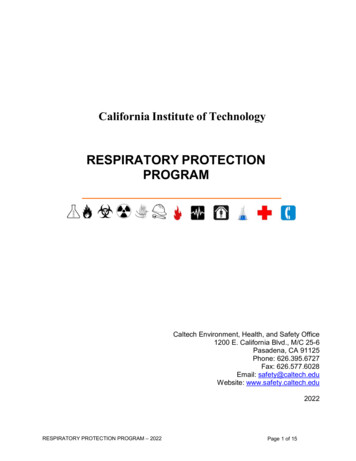
Transcription
California Institute of TechnologyRESPIRATORY PROTECTIONPROGRAMCaltech Environment, Health, and Safety Office1200 E. California Blvd., M/C 25-6Pasadena, CA 91125Phone: 626.395.6727Fax: 626.577.6028Email: safety@caltech.eduWebsite: www.safety.caltech.edu2022RESPIRATORY PROTECTION PROGRAM – 2022Page 1 of 15
*** THIS PAGE INTENTIONALLY LEFT BLANK ***RESPIRATORY PROTECTION PROGRAM – 2022Page 2 of 15
RESPIRATORY PROTECTION PROGRAMTable of ContentsPURPOSE . 4SCOPE . 4RESPONSIBILITIES . 4SUPERVISORS . 4RESPIRATOR USERS . 4ENVIRONMENT, HEALTH, AND SAFETY. 4PHYSICIAN OR OTHER LICENSED HEALTH CARE PROFESSIONAL (PLHC’P):. 4RESPIRATOR SELECTION AND CARTRIDGE CHANGE SCHEDULE SUMMARY. 4MEDICAL EVALUATION . 5PROCESS . 6TRAINING . 6FIT TESTING . 7MAINTENANCE AND USE . 7INSPECTION, CLEANING, AND REPAIRS . 7APPENDIX A: TYPES OF RESPIRATORS . 8AIR-PURIFYING RESPIRATORS . 8NEGATIVE- AND POSITIVE-PRESSURE RESPIRATORS . 8ASSIGNED PROTECTION FACTORS. 8TABLE 1. – ASSIGNED PROTECTION FACTORS5 . 9CARTRIDGE AND CANISTER WARNING SYSTEMS . 10APPENDIX B : INFORMATION FOR EMPLOYEES USING RESPIRATORS WHEN NOT REQUIRED UNDER THESTANDARD. 11APPENDIX C: TRAINING & FIT TESTING RECORD . 12TRAINING REVIEW GUIDELINES . 13APPENDIX D: RESPIRATOR FIT CHECKS . 14NEGATIVE PRESSURE CHECK . 14POSITIVE PRESSURE CHECK. 14APPENDIX E : RESPIRATOR FIT TESTING GUIDELINES . 15RESPIRATORY PROTECTION PROGRAM – 2022Page 3 of 15
PURPOSEThe purpose of the Respiratory Protection Program is to ensure protection to Instituteemployees from inhalation of harmful substances. Respirators may be necessary in somesituations when effective engineering controls are not feasible. This Program complies with Title8 of the California Code of Regulations, § 5144, Respiratory Protection.SCOPEThis Program applies to all Institute employees who are required to wear respirators duringnormal and non-routine work operations.RESPONSIBILITIESSUPERVISORSThe Supervisors’ responsibilities under the Program include: Identifying employees subjected to hazardous conditions that may require the use of arespirator; Ensuring affected employees are aware of specific respirator requirements in their area; Ensuring employees comply with the Program requirements; and Making respirators available for authorized users.RESPIRATOR USERSRespirator Users’ responsibilities under the Program include: Completing the appropriate medical evaluation, training, and fit testing; Ensuring that the respirator is properly maintained, cleaned, and stored; Wearing the respirator in an appropriate manner; Reporting any problems associated with wearing the respirator to his/her Supervisor; Inspecting the respirator before each use; and Reporting any malfunction of the respirator to his/her Supervisor.ENVIRONMENT, HEALTH, AND SAFETYThe Environment, Health, and Safety Office (EHS) oversees the Respiratory ProtectionProgram. EHS’s responsibilities under the Program include: Performing hazard assessments; Selecting and issuing suitable respiratory protection options; Ensuring that respirator training and fit-testing are conducted; Maintaining training and fit testing records; and Evaluating the effectiveness of Program elements.PHYSICIAN OR OTHER LICENSED HEALTH CARE PROFESSIONAL (PLHC’P):The occupational health providers are responsible for: Performing medical evaluations using a medical questionnaire or an initial medicalexamination that obtains the same information as the medical questionnaire; Performing necessary follow-up examinations to determine ability to wear a respirator; Providing a written evaluation of the employee’s ability to use a respirator; and Maintaining records of such evaluations.RESPIRATOR SELECTION AND CARTRIDGE CHANGE SCHEDULE SUMMARYThe EHS Office determines the type of respirator necessary for a given task. The decision isbased on a hazard assessment of the task. The hazard assessment takes into account theparticular airborne contaminant hazard, exposure levels, and engineering controls in place.RESPIRATORY PROTECTION PROGRAM – 2022Page 4 of 15
A number of respirator sizes and models are provided to employees through the EHS office sothat the respirator they select is comfortable and provides an acceptable fit. Respirators,cartridges, filters and other components shall be National Institute for Occupational Safety andHealth (NIOSH) certified. Respirators may be filtering facepieces, (dust masks), half or fullface air purifying respirators, powered air purifying respirators (PAPR), supplied airrespirators, (See Appendix A – Types of Respirators). When recommending an air-purifyingrespirator, the appropriate filter types will be selected. Cartridge change schedules will beissued as appropriate. Respirator selection is documented. Departments purchase andmaintain appropriate respirators and supplies.Respirator selection considers these elements: Effectiveness of the device against the substance(s) of concern; Estimated maximum exposure concentration; General environment; Known limitations of respirators; and Comfort, fit, and worker acceptance.Particulate filtersParticulate filter change in the absence of oil aerosols will be required when the userdetects increased breathing resistance, or the filter becomes soiled or damaged.Where a particulate filter is used in an environment with oil aerosols, the manufacturer’srecommended service life for their P-series filters will be used. Should R-series filtersbe used in an oil aerosol environment, the filter will be discarded after 8 hours of use.End-of-Service Life Indicators (ESLI)When appropriate NIOSH-certified cartridges with ESLI are available to protect againsta workplace contaminant, the ESLI may be used as an indication that the cartridge isno longer adequate for employee protection.Cartridge Change SchedulesThe workplace will be assessed for contaminant concentrations as part of the hazardevaluation. When the contaminants include gases and vapors, the Industrial Hygienistwill provide cartridge change information to the respirator user or group of users, foreach task requiring respiratory protection. Cartridge change schedules will be createdbased on calculated cartridge service life, taking into consideration the nature of thecontaminant or mixture of contaminants, the accuracy of the workplace concentrationmeasurements, the presence of other organic vapors, the possibility of high relativehumidity, potential for cartridge bed migration, warning properties of the contaminant,and any other factor found to be important in the hazard assessment. Where possible,cartridge change schedules will be developed using the manufacturer’s service lifecalculators.MEDICAL EVALUATIONEmployees are not allowed to wear respirators unless they are physically able to perform theirwork while wearing the equipment. A licensed health care professional from one of the Caltechoccupational health providers determines respiratory protection restrictions, if any, based onthe individual’s physical status through the review of a medical questionnaire that employeessubmit online, supplemental information, and medical tests, as appropriate. The occupationalphysician, in accordance with OSHA medical surveillance requirements, determines specificmedical tests and procedures. Tests and procedures will be reviewed periodically. Follow-upRESPIRATORY PROTECTION PROGRAM – 2022Page 5 of 15
medical examinations shall be provided for an employee whose initial medical questionnaire ormedical examination demonstrates the need for a follow-up medical examination. Supplementalinformation provided to the health care professional includes: The type and weight of the proposed respirator; The duration and frequency of respirator use; The expected physical work effort; Additional protective equipment and equipment to be worn; and Temperature and humidity extremes that may be encountered.The health care professional will provide the Institute and employee written recommendationsregarding the employee’s ability to use a respirator.Future evaluations are made when there is a change to workplace conditions increasing anindividual’s physiological burden, the user reports related medical signs or symptoms, or if thereis a recognized need for reevaluation.Medical evaluations are not required to include those employees whose only use of respiratorsinvolves the voluntary use of filtering facepieces (dust masks) in a written RespiratoryProtection Program. (See Appendix B – Information For Employees Using Respirators WhenNot Required Under The Standard).PROCESSRisk Assessment and Medical Questionnaire Forms will be submitted directly to theOccupational Health physician. The medical questionnaire will be evaluated by the PLHCP anddiscussed confidentially (if needed) with the applicant.To complete the Respiratory Medical Evaluation, please access the online tool as follows:1) Access the Office 365 landing page: https://caltech.sharepoint.com/sites/citlaohp.2) To login, type in your IMSS user name with the Caltech.edu email suffix (e.g.,Username@caltech.edu) then click on the Tab or Enter key on your keyboard. Apassword is not required on this page. You will be redirected to the Caltech Office 365Login.a. Enter your IMSS Username and Password in Office 365. The LAOHP websitewill open. NOTE: If you are a NEW participant or are unable to access theLAOHP website after entering your IMSS User Name and Password, pleaseopen a ticket with IMSS to request access to the LAOHP site.b. Select request type IMSS Office 365 SharePoint Request Access toExisting SharePoint Site LAOHP / Respiratory Protection Programc. You will receive an email notification from IMSS within 48 hours when you haveaccess to the LAOHP homepage. Note, you may also select the RespiratorProtection Program link from the homepage of the LAOHP.3) Once PHLCP determines that the individual is medically fit to wear a respirator, arespirator clearance email is sent to EH&S and to the respirator user. Respiratortraining and fit testing are then scheduled with respirator wearer.TRAININGIndividuals required to wear respirators must receive training and fit testing prior to using therespirator (See Appendix C – Training and Fit Testing Record).The training program includes: Respiratory hazards to which employees are potentially exposed during routine andRESPIRATORY PROTECTION PROGRAM – 2022Page 6 of 15
emergency situations;Elements of the program;Use and limitations of respiratory protection;User responsibilities;Maintenance and storage; andMedical signs and symptoms limiting the effective use of respirators.Retraining is administered annually as well as in response to changing conditions or otherindications. Training completion is documented by the EHS Office.FIT TESTINGIndividuals required to wear respirators must be properly fitted to ensure an adequate sealprior to initial use. Respirator Fit Testing and Training are provided upon the successfulcompletion of the Respirator Medical Evaluation. The employee or his/her Supervisor shouldarrange for an appointment for Respirator Training and fit testing. Employees shall followprocedures for respirator fit checks as described in Appendix D for Respirator Fit Checksand related fit testing guidelines as outlined in Appendix E – Respirator Fit TestingGuidelines. Users who have facial hair or a condition that interferes with the face-to-facepieceseal or valve function cannot wear fitting respirators per Appendix E – Respirator Fit TestingGuidelines.Fit tests are a determining factor in the type, model, and size selection of respirators. The EHSOffice performs fit testing to certify the ability of the user to obtain a satisfactory fit. Users mustpass the fit test before final issuance of a respirator. Instructions for performing fit checks inthe field are provided to users. Additional fit testing is conducted annually and whenever thereare changes in the users’ physical condition that could affect respirator fit.MAINTENANCE AND USEINSPECTION, CLEANING, AND REPAIRSPersonal protective equipment (e.g., safety glasses) must not interfere with the seal of thefacepiece to the face of the user. Fit checks must be performed prior to each use of a tight-fitting respirator.Respirators must be cleaned and disinfected as often as necessary to maintain a sanitarycondition. Emergency respirators must be cleaned after each use.Store respirators in a sealed container when not in use. Do not store in such a way that thenatural shape of the respirator becomes distorted.Respirators shall be inspected before each use and during cleaning. Respirator inspectionsshall be checked for function, tightness of connections, and the condition of the variousparts including, but not limited to, the facepiece, head straps, valves, connecting tube, andcartridges, canisters or filters; and a check of elastomeric parts for pliability and signs ofdeterioration.Respirators that fail an inspection or are otherwise found to be defective are to be removedfrom service.RESPIRATORY PROTECTION PROGRAM – 2022Page 7 of 15
APPENDIX A: TYPES OF RESPIRATORSDifferent types of respirators are designed to protect against specific respiratory hazards. Theatmosphere and the air contaminant levels that workers encounter at work dictate the type ofrespirator that must be worn.Respirators are available in many types, models, and sizes from several manufacturers for avariety of applications. Described below are the air-purifying respirators.AIR-PURIFYING RESPIRATORSAir-purifying respirators work by removing gas, vapor, particulates, or combinations of gas,vapor, and/or particulates from the air through the use of filters, cartridges, or canisters. To helpemployees with identifying the specific chemicals that the cartridges are designed for, all filters,cartridges, and canisters must be labeled and color-coded with an approval label provided bythe National Institute of Occupational Safety and Health (NIOSH).Examples of air-purifying respirators include: Filtering facepiece respirators, which are often called dust masks. Tight-fitting respirators, which have either a half mask or a full facepiece. Powered Air-Purifying Respirators (PAPRs) which have a hood, a helmet, a tight-fittingfacepiece, or a loose-fitting facepiece.o PAPRs have a battery powered blower to supply purified air.Air-purifying respirators not designed for use in conditions that are Immediately Dangerous toLife or Health (IDLH) and must not be used when entering an area that is oxygen deficient (O2 19.5% by volume). IDLH is a term that is used to describe an atmosphere that poses animmediate threat to life, which would cause irreversible adverse health effects or that wouldimpair a person’s ability to escape from a dangerous atmosphere.NEGATIVE- AND POSITIVE-PRESSURE RESPIRATORSBoth air-purifying respirators and atmosphere-supplying respirators may be further classified onthe basis of their functioning as either negative-pressure respirators or as positive-pressurerespirators.Negative-pressure respirators are tight-fitting respirators that work by creating pressuredifferences between the volume of air inside and outside the respirator. As the wearer of arespirator breathes in, the pressure inside the facepiece is reduced, which forces air from outsidethe facepiece to be pulled through the inlet covering, to replace what was inhaled. Types ofnegative-pressure respirators include filter facepiece “dust masks”, half masks, and fullfacepiece, air-purifying respirators.Positive-pressure respirators are respirators that have a breathing air source that pushes airthrough the inlet covering of the respirator. The pressure inside the respirator exceeds the airpressure outside the respirator.ASSIGNED PROTECTION FACTORSDifferent types of respirators have different limits on how effective they are in protecting againstair contaminants. The Assigned Protection Factor (APF) of a respirator reflects the level ofprotection that a properly maintained and functioning respirator can be expected to provide to aRESPIRATORY PROTECTION PROGRAM – 2022Page 8 of 15
population of properly fitted and trained users.Different types of respirators have different APFs. Tight-fitting, half-mask, air-purifying respiratorshave the lowest APF, and SCBAs have the highest protection factor. An APF of 10 means thatthe concentration of air contaminants inside the respirator facepiece is reduced by a factor of 10.The Institute relies on APFs published by NIOSH and the American National Standards Institute(ANSI). Cal/OSHA has enforceable APFs that are contained in substance-specific healthstandards.TABLE 1. – ASSIGNED PROTECTION FACTORS5Type of respirator 1,21. Air-PurifyingRespiratorQuartermask52. Powered AirPurifying ngfacepiece50.501,0004Halfmask31025/1,000253. Supplied-AirRespirator (SAR) orAirline RespiratorDemand mode.1050.Continuous flowmode.501,0004Pressure-demand orother positivepressure mode.501000.Demand mode.105050.Pressure-demand orother positivepressuremode (e.g., open /closed circuit).10,00010,00025/1,000.254. Self-ContainedBreathing Apparatus(SCBA)Notes:1. Employers may select respirators assigned for use in higher workplace concentrations of ahazardous substance for use at lower concentrations of that substance, or when requiredrespirator use is independent of concentration.2. The Assigned Protection Factors (APF) in Table 1 are only effective when the employerRESPIRATORY PROTECTION PROGRAM – 2022Page 9 of 15
implements a continuing, effective respirator program as required by this section, includingtraining, fit testing, maintenance, and use requirements.3. This APF category includes filtering facepieces, and half masks with elastomeric facepieces.4. The employer must have evidence provided by the respirator manufacturer that testing ofthese respirators demonstrates performance at a level of protection of 1,000 or greater toreceive an APF of 1,000. This level of performance can best be demonstrated by performinga Workplace Protection Factor (WPF) or simulated WPF study or equivalent testing. Absentsuch testing, all other PAPRs and SARs with helmets/hoods are to be treated as loose-fittingfacepiece respirators, and receive an APF of 25.5. These APFs do not apply to respirators used solely for escape. For escape respirators usedin association with substances covered by substance-specific standards in Title 8, Division 1,Chapter4, Subchapters 4, 7, and 18, employers must refer to the appropriate substancespecific standards. Escape respirators for other IDLH atmospheres are specified bysubsection (d)(2)(B).CARTRIDGE AND CANISTER WARNING SYSTEMSThe useful service life of a cartridge or canister is defined by how long it provides employees withadequate protection from harmful chemicals in the air. The service life of a cartridge depends onmany factors, including environmental conditions (e.g., high humidity), breathing rate, cartridgecapacity, the amount of contaminant in the air, and how many hours the cartridge is used.For air-purifying respirators that protect against gases and vapors, a system must be in effectthat will reliably warn respirator wearers of contaminant breakthrough. These systems include anEnd-of-Service-Life Indicator (ESLI) or an established and enforced cartridge or canister changeschedule. Some cartridges and canisters are equipped with an ESLI system that warns the userof the end of adequate respiratory protection. The indicator is usually a sorbent material thatchanges color when the cartridge approaches saturation or is no longer effective. However, fewcartridges are currently equipped with an ESLI. In this situation, a cartridge or canister changeschedule will be developed and provided to the respirator user.RESPIRATORY PROTECTION PROGRAM – 2022Page 10 of 15
APPENDIX B : INFORMATION FOR EMPLOYEES USING RESPIRATORS WHENNOT REQUIRED UNDER THE STANDARDRespirators are an effective method of protection against designated hazards when properlyselected and worn. However, if a respirator is used improperly or not kept clean, the respiratoritself can become a hazard to the worker. Sometimes, workers may wear respirators to avoidexposures to hazards, even if the amount of hazardous substance does not exceed the limits setby OSHA standards.If respirators are for voluntary use, or if an employee provides his/her own respirator, he/sheneeds to take certain precautions to be sure that the respirator itself does not present a hazard.Respirator wearer should:1Read and heed all instructions provided by the manufacturer on use, maintenance,cleaning and care, and warnings regarding the respirators’ limitations;2Choose respirators certified for use to protect against the contaminant of concern;3NIOSH, the National Institute for Occupational Safety and Health of the U.S.Department of Health and Human Services, certifies respirators. A label or statementof certification should appear on the respirator or respirator packaging. It will tell wearerwhat the respirator is designed for and how much it will protect him/her;4Do not wear your respirator into atmospheres containing contaminants for whichyour respirator is not designed to protect against. For example, a respirator designedto filter dust particles will not protect you against gases, vapors, or very small solidparticles of fumes or smoke; and5Keep track of your respirator so that you do not mistakenly use someone else’srespirator.RESPIRATORY PROTECTION PROGRAM – 2022Page 11 of 15
APPENDIX C: TRAINING & FIT TESTING RECORDName DateDepartmentRespiratory HazardsI.Respirator Type Filtering Facepiece½ Face Air Purifying Full Face PAPRFull Face Air Purifying Full Face SCBAFull Face Supplied AirOther 3M Moldex North Wilson OtherII. Small TrainingIII.Qualitative Fit Test MediumTEST:Negative Fit TestPositive Fit TestSensitivity Test:Isoamyl AcetateSaccharin #Squeezes: 10 20 30 Fit Test:Isoamyl Acetate (Organic Vapor Filter)Saccharin (Particulate Filter) LargeRESULTS:Pass Pass FailFail N/AN/A PassPass FailFail N/AN/A PassPass FailFail N/AN/A Comments:Repeat Fit Test Before:Test Conductor: Employee Signature:- - - - - - - - - - - - - - - - - - - - - - - - - - - - - - - - - - - - - - - - - - - - - - - - - - - - - - - - - - - - - - -PTA Account:Date BilledAmount: Entered into databaseRESPIRATORY PROTECTION PROGRAM – 2022Page 12 of 15
TRAINING REVIEW GUIDELINESThis respirator has been issued to you for a specific airborne contaminant. IT WILL NOTPROTECT YOU FROM OTHER CONTAMINANTS. The following are reminders of theinstruction you have received:MAINTENANCE check before each use:a) Sealing surface clean and free of cracks and holes.b) Inhalation and exhalation valves are clean and seated properly.c) Straps are sufficiently elastic and free of worn areas.CHECK OF PROPER FIT AND FUNCTION prior to each use:a) Positive pressure user seal check (Close off exhalation valve and exhale).b) Negative pressure user seal check (Close off cartridges and inhale).CLEAN MASK ON A REGULAR BASIS with a mild soap and warm water solution andallow it to air dry overnight. (Make sure the cartridges / filters are removed from therespirator before cleaning).STORE respirators and filter cartridges in Ziploc storage bags, or other protectiveenclosure, away from excessive heat sources, contaminated work areas, and harshchemicals.DO NOT STORE items on top of respirator which could deform the facepiece shape.Be familiar with MATERIAL PROPERTIES of the substance you are using the respiratorto protect yourself from. Some contaminants require the cartridges to be changed every4-8 hours, regardless of exposure level. Consult the SDS or contact EHS for thisinformation.CHANGE CARTRIDGES/FILTERS as required. (IMPORTANT – In addition to followingcartridge change schedules, change cartridges/filters if you experience an increasedresistance in breathing or when you detect contaminant odors or taste while wearing yourrespirator).MASK TO FACE SEAL must be unobstructed by facial hair. You must be clean-shavento obtain an effective seal.If you use safety equipment that may interfere with the sealing of your respirator, youneed to be fit tested while wearing the PPE that you use.This respirator has been assigned to you only - DO NOT LOAN it to anyone else.FIT TESTING must be repeated immediately when any of the following has taken place:a) User weight change of 20 lbs. or moreb) Facial scarring in the area of the face-piece sealc) Significant dental changes (Multiple extractions without prosthesis, or acquiringdentures)d) Reconstructive or cosmetic surgerye) Any other condition that may interfere with the facepiece sealRecognition of medical signs and symptoms that may limit or prevent effective use.RESPIRATORY PROTECTION PROGRAM – 2022Page 13 of 15
Employee Signature: Date:APPENDIX D: RESPIRATOR FIT CHECKSEach time a respirator is donned, the user performs positive and negative fit checks. Fit checksare not a substitute for fit testing performed by the EHS Office or an authorized OccupationalHealth Care Provider.NEGATIVE PRESSURE CHECKThis test cannot be performed on all respirators. It can be performed on the facepieces of airpurifying respirators with tight-fitting inlet covers. It can also be performed on SCBA respiratorsequipped with breathing tubes that can be squeezed at the inlet to prevent passage of air.To perform the negative pressure check:1 Close the inlet opening. This is addressed by covering the canister, cartridge, or filter withthe palm of the hand or squeezing the inlet tube.2 Inhale gently and hold for at least 10 seconds.The facepiece should collapse slightly with no detectable inward leakage of air into thefacepiece. It can be reasonably assumed that the respirator is properly positioned and theexhalation valve and facepiece are not leaking when performing a negative pressure check.POSITIVE PRESSURE CHECKThis test cannot be performed on all respirators. Respirators with exhalation valves can betested. To perform the positive pressure check:1Close the exhalation valve or breathing tube with the palm of the hand; and2Exhale gently.A properly positioned facepiece will build up a slight positive pressure. There should be nodetection of outward leakage between the sealing surface of the facepiece and the face whenperforming a positive pressure check.RESPIRATORY PROTECTION PROGRAM – 2022Page 14 of 15
APPENDIX E : RESPIRATOR FIT TESTING GUIDELINESA “fit test” tests the seal between the respirator's facepiece and your face. It takes about fifteento twenty minutes to complete and is performed at least annually. After passing a fit test with arespirator, you must use the exact same make, model, style, and size respirator on the job thatyou were tested on.1Respirator wea
Training completion is documented by the EHS Office. FIT TESTING Individuals required to wear respirators must be properly fitted and tested to ensure an adequate seal prior to initial use. Respirator Fit Testing and Training are provided upon the succes
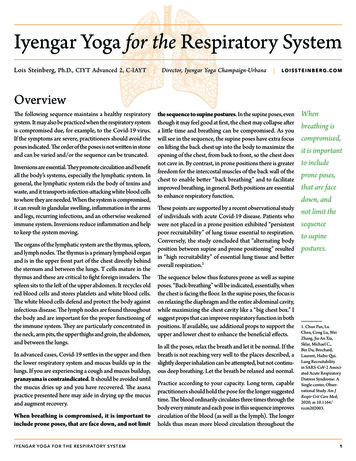
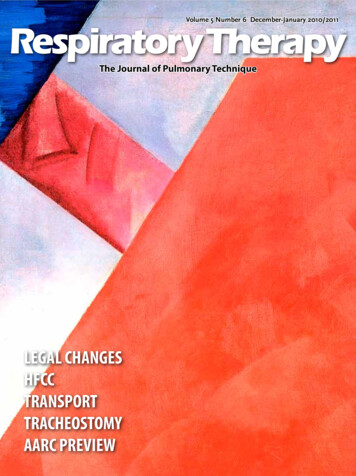

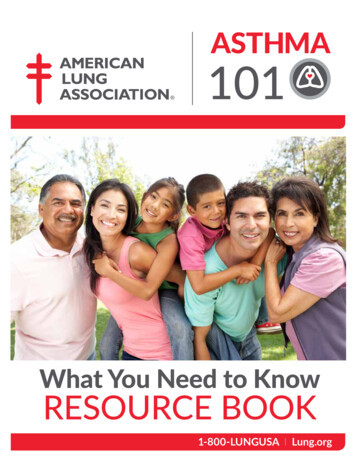
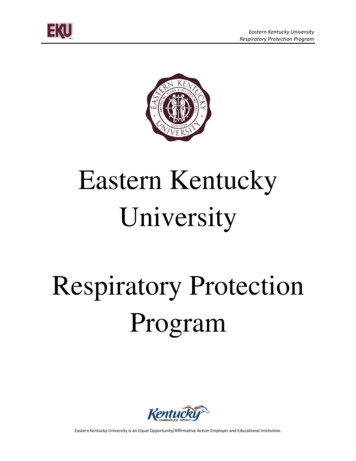
![N95 Respirators Training August 2012 Final - HS [Read-Only]](/img/20/n95-respirators-training.jpg)
